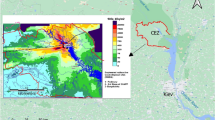Abstract
Studies of uranium series geochemistry have made relatively little impact on performance assessment where simplistic advection-dispersion models are still being used to derive dose and risk estimates. Supplementing the models with a scientifically sound representation of radionuclide migration would greatly enhance the rigour and transparency of the safety case. This paper outlines a methodology for employing natural geochemical fluxes as alternative indicators of repository safety by reference to case studies in Finland. The approach may be applied to any situation where a comparison between ambient exposure rates and increments received due to industrial activities is required.
Access this chapter
Tax calculation will be finalised at checkout
Purchases are for personal use only
Preview
Unable to display preview. Download preview PDF.
Similar content being viewed by others
References
Armands G (1967) Geochemical prospecting of a uraniferous bog at Masugnysbyn, N. Sweden. A Kvalheim Ed Geochemical Prospecting in Fennoscandia. Interscience: 127-154
Blomqvist R, Ruskeeniemi T, Kaija J, Ahonen L, Paananen M, Smellie J, Grundfelt B, Pedersen K, Bruno J, Perez del Villar L, Cera E, Rasilainen K, Pitkänen P, Suksi J, Casanova J, Read D, Frape S (2000) The Palmottu natural analogue project - Phase II: Transport of radionuclides in a natural flow system at Palmottu. CEC Report EUR 19611
Bonano EJ, Davis PA, Cranwell R (1988) Demonstration of a performance assessment methodology for high level waste disposal in basalt formations. Sandia Report 86-2325
Braun J-J, Pagel M, Herbillon A, Rosin C (1993) Mobilisation and redistribution of REEs and thorium in a syenitic lateritic profile: A mass balance study. Geochim Cosmochim Acta 57: 4419-4434
Burns PC, Finch RJ Eds (1999) Uranium: Mineralogy, geochemistry and the environment. Min Soc Am, Reviews in Mineralogy 38:679p
Carle W (1975) Die Mineral und Thermalwasser von Mitteleuropa. Geologie, Chemismus, Genese. Bucher der Zeitschrift Naturwissenschaftliche Rundschau. Wissenschaftliche Verlagsgesellschaft MbH, Stuttgart
Chapman NA, McKinley IG, Shea ME, Smellie J (1991) The Pocos de Caldas Project: Summary and implications for radioactive waste management. SKB Report 90-24
Crawford MB, Wilmot RD (1998) Normal evolution of a spent fuel repository at the candidate sites in Finland. Posiva Report 98-15
Cuney M, Mathieu R (2000) Extreme light rare earth element mobilisation by diagenetic fluids in the geological environment of the Oklo natural reactor zones, Franceville basin, Gabon. Geology 28: 743-746
Duerden P, Lever DA, Sverjensky DA, Townley LR (1994) Summary of findings: Alligator Rivers Analogue Project. UKDOE Report DOE/HMIP/RR/92.072
Eng T, Hudson J, Stephansson O, Skagius K, Wibourg M (1994) Scenario development methodologies. SKB Technical Report TR-94-28
Halbach P, van Borstel D, Gundermann KD (1980) The uptake of uranium by organic substances in a peat bog environment on a granitic bedrock. Chem Geol 29: 117-138
Hellmuth K-H, Backman B, Blomqvist R, Kaija J, Salminen R, Savolainen H, Tarvainen T (2001) Natural geochemical concentrations and fluxes on the Baltic Shield of Finland as indicators of nuclear waste repository safety. STUK Progress Report, IAEA CR.
Kaija J, Rasilainen K, Blomqvist R (2002) The use of selected safety indicators (concentrations, fluxes) in the assessment of radioactive waste disposal. Site-specific natural geochemical concentrations and fluxes at the Palmottu U-Th mineralisation (Finland) for use as indicators of nuclear waste repository safety. STUK Report (draft), IAEA CRP
Kellaway GA Ed (1991). Hot Springs of Bath. Bath City Council
Miller W (2000) Potential natural safety indicators and their application to radioactive waste disposal in the UK. Nirex Report 6297A-1, Version 2
Miller W, Alexander R, Chapman N, McKinley I, Smellie J (1994) Natural analogue studies in the geological disposal of radioactive wastes. Studies in Environmental Science 57 Elsevier Amsterdam 395p
Nirex (2000) Generic performance assessment. Nirex Report S/REP/331665
Porcelli D, Andersson PS, Wasserburg GJ, Ingri J, Baskaran, M (1997) The importance of colloids and mires for the transport of uranium isotopes through the Kalix River watershed and the Baltic Sea. Geochim Cosmochim Acta 61: 4095-4113
Porcelli D, Andersson PS, Baskaran M, Wasserburg GJ (2001) Transport of U and Th series nuclides in a Baltic Shield watershed and the Baltic Sea. Geochim Cosmochim Acta 65: 2439-2459
Read D, Hooker PJ (1992) Using data from natural geochemical environments to improve models of uranium speciation in groundwaters. J Geochem Explor 46: 63-81
Read D, Bennett DG, Hooker PJ, Ivanovich M, Longworth, G, Milodowski A, Noy D (1993) The migration of uranium into peat-rich soils at Broubster, Caithness, Scotland. J Contam Hydrol 13: 291-308
Skagius K, Strom A, Wiborgh M (1995) The use of interaction matrices for identification, structuring and ranking of FEPs in a repository system. SKB Report TR-95-22
SKB (1999) Deep repository for spent nuclear fuel: SR97 - post closure safety. SKB Report TR-99-06
Tarvainen T, Backmann B, Hellmuth K-H, Hatakka T, Savolainen H (2002) The use of selected safety indicators (concentrations, fluxes) in the assessment of radioactive waste disposal. Erosion rates on the Baltic Shield of Finland for use as indicators of nuclear waste repository safety. STUK Report (draft)
Thompson BGJ, Sagar B (1993) The development and application of integrated procedures for post-closure assessment based upon Monte Carlo simulation: The probabilistic systems assessment (PSA) approach. J Rel Eng Sys Safety 42: 125-160
Traber D (2002) The use of selected safety indicators (concentrations, fluxes) in the assessment of radioactive waste disposal. Geohydraulic and geochemical basis of geochemical fluxes from deep groundwaters observed at the Earth’s surface. STUK Report (draft)
Vieno T, Nordman H (1999) Safety assessment of spent fuel disposal in Hastholmen, Kivetty, Olkiluoto and Romuvaara, TILA-99. Posiva Report 99-07
Author information
Authors and Affiliations
Editor information
Editors and Affiliations
Rights and permissions
Copyright information
© 2002 Springer-Verlag Berlin Heidelberg
About this paper
Cite this paper
Read, D., Hellmuth, KH., Kaija, J., Ahonen, L. (2002). Natural Uranium Fluxes and their Use in Repository Safety Assessment. In: Merkel, B.J., Planer-Friedrich, B., Wolkersdorfer, C. (eds) Uranium in the Aquatic Environment. Springer, Berlin, Heidelberg. https://doi.org/10.1007/978-3-642-55668-5_13
Download citation
DOI: https://doi.org/10.1007/978-3-642-55668-5_13
Publisher Name: Springer, Berlin, Heidelberg
Print ISBN: 978-3-642-62877-1
Online ISBN: 978-3-642-55668-5
eBook Packages: Springer Book Archive




